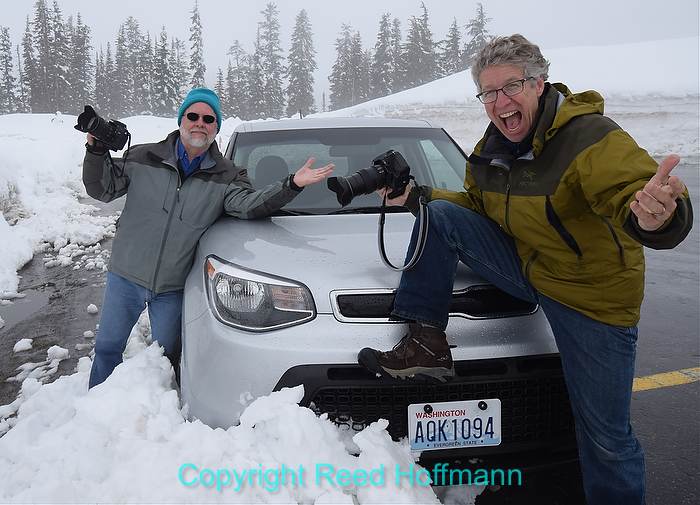Last weekend I taught Nikon School in Seattle with my good friend and co-instructor Bill Durrence. I’ve been fortunate to visit Seattle many times over the years, for schools, workshops and business with Microsoft. It’s a beautiful city in one of the most scenic parts of the country, and occasionally flying in I’d get a view of Mt. Rainier. But despite all those trips, I’d never had time to make the two-hour drive to photograph Mount Rainier. This time I would.
When possible, I try to mix business with pleasure. It seems a shame to fly around the country and see nothing but airports and hotels. So when possible, I arrive early or stay late. In this case we stayed an extra day, and at 5:30 Monday morning I’d picked up the rental car and we were on our way.
When I landed in Seattle last Friday, it was one of those rare clear days where Mt. Rainier was visible across the region. By Saturday the rain had returned, and we drove to the mountain Monday morning in a steady drizzle. Arriving at the entrance gate, I followed my own advice. In workshops, I tell people that when they’re new to a place, it’s best to do a quick scout of as much of the area as possible before starting to shoot. Once you know what’s there, you’ll know how best to spend your time. At the park entrance, we picked up a map and decided to drive as far as they’d let us. Despite it being May and around 80-degrees in Seattle the previous week, many roads in the park were still closed due to snow.

Our first stop was to shoot the fresh snow coating the hillsides. Believe it or not, this is a color photo. There just wasn’t any in this scene.
Shot with a Nikon D800, Aperture Priority, ISO 200, 1/800 at f/8, EV -0.3, 24-120mm lens at 105mm. Photo copyright Reed Hoffmann.
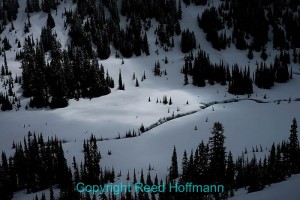
From the upper visitor center we had views of a valley, and watched the sun spotlight sections of it when the clouds occasionally parted. The challenge was to expose for the brightest (sunlit) areas.
Shot with a Nikon D800, Aperture Priority, ISO 100, 1/1000 at f/8, EV -0.3, 24-120mm lens at 50mm. Photo copyright Reed Hoffmann.
First, let me say that Rainier is one beautiful park. Thanks to the massive amounts of rain in the northwest, the lower parts of the park practically glow green. It was hard not to stop and shoot at every pull-out. But we managed to keep driving until we reached the clouds and started seeing fresh snow from overnight. Rain in Seattle meant snow up here. So we made a quick five-minute stop before pushing on to the end of the road. And the end was at Paradise Visitor Center, where a snowplow driver was apparently trying to see how fast his truck would go while clearing the parking lot. Fast enough that I nearly dove into a snow bank to get out of the way. Yes, there was snow, and yes, it was deep.
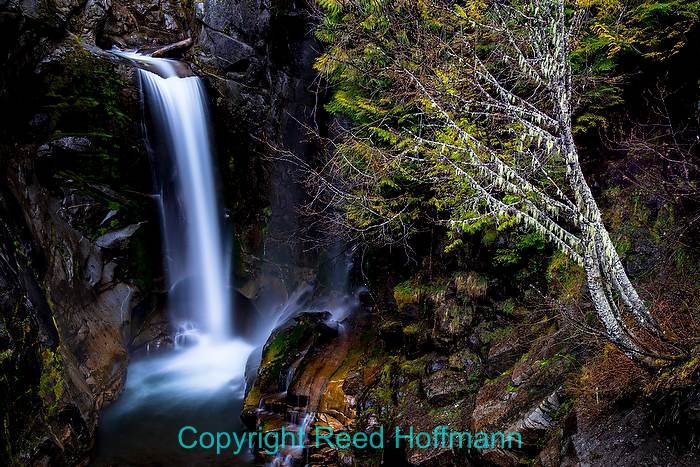
My favorite scene in the park was at Christine Falls. By sliding down a snow-covered trail I was able to reach an overlook back towards the falls, and the moss-covered tree at right really made the shot. I used an 8-stop neutral density filter to get the long exposure required to get that cottony look from the waterfall. And of course, I had the camera on a tripod.
Shot with a Nikon D800, Manual mode, ISO 100, 15-seconds at f/10, EV -1.0, 24-120mm lens at 50mm. Photo copyright Reed Hoffmann.
I’m a big fan of planning. When I’m going somewhere to shoot, I not only want to have the right camera equipment, I also want to have the right clothing. If I’m not comfortable, I’m not concentrating on photography. And sometimes it’s a safety issue too. In this case Bill and I both expected cold weather as we went up the mountain, including snow. We’d brought the right winter gear, including gloves and hats, and were wearing boots. What we forgot, though, was gaiters. Popular for winter sports and backpacking, these are fabric sleeves that seal the gap between your pants and your shoes, to keep gravel and snow out. So as we tramped around exploring this winter wonderland, our boots slowly filled with snow. Luckily we were just there for the day, and could retreat to our warm and dry car.
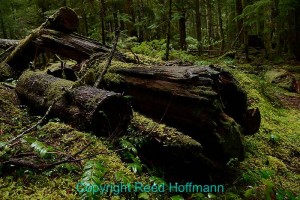
Stepping off the road into the forest we walked across an incredibly soft floor of moss and vegetation to explore the scenes within. The green was nearly electric.
Shot with a Nikon D800, Aperture Priority, ISO 200, 1/20 at f/5.6, EV -2.0, 24-120mm lens at 24mm. Photo copyright Reed Hoffmann.

With great landscapes all around, it’s easy to forget to look for the details. I loved the pattern of these limbs, which I could look down on from a bridge.
Shot with a Nikon D800, Aperture Priority, ISO 320, 1/160 at f/5.6, EV -1.3, 24-120mm lens at 120mm. Photo copyright Reed Hoffmann.
Once we’d explored the upper reaches of the park, we could then work our way back down, stopping to shoot as we went. And that’s how we spent the next eight hours, driving up and down the mountain, getting out and exploring the different areas. It was rainy, it was cold, and it was beautiful. By late afternoon the heavier clouds moved in and a constant, cold rain was falling. That was our cue to head back to Seattle.

I have an old camera that’s been converted to infrared and brought it along. Generally you need sunlight to make that work, but in this case the bright green foliage was enough. Afterwards I converted the image to black-and-white.
Shot with a Nikon D80, Aperture Priority, ISO 200, 1/80 at f/8, EV -1.7, 10-24mm lens at 10mm. Photo copyright Reed Hoffmann.
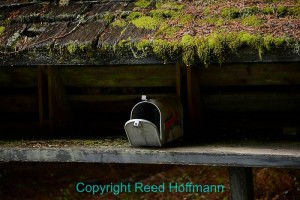
On our way back to Seattle I stomped on the brakes after driving past this mailbox, then made a quick U-turn to come back and shoot it. I loved the lonely, forlorn look it had.
Shot with a Nikon D800, Aperture Priority, ISO 400, 1/30 at f/4.5, EV -2.3, 24-120mm lens at 120mm. Photo copyright Reed Hoffmann.
Arriving at the hotel two hours later, it was like landing in a different world – warm air with a dramatic sunset of clouds and sunshine. And to the southeast… a solid blanket of heavy clouds. We never saw the summit of Mt. Rainier that Monday, but that’s okay. What we saw instead were slices of astounding beauty, and that left us with a strong desire to return. So if your travels take you to the northwest, make time for a trip to Mt. Rainier. You won’t regret it.

